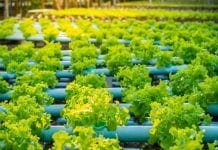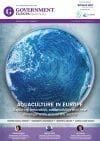
Dr. Camille Bellet, post-doctoral research associate from the University of Liverpool speaks to GE on antimicrobials and the social and political nature of the medicalisation of animal farming.
Animal farming currently poses one of the most pressing health concerns in humans. However, this concern is not that of a direct nature, but is related to the rise of antimicrobial resistance (AMR). Farmers around the world use antimicrobials to treat a variety of infectious diseases in their livestock. The increasing use of antimicrobials can lead to the selection of resistant bacteria that can pass through the food chain and be spread to humans. The issue of AMR represents one of the many risks and problems related to the medicalisation of animal farming. Yet it is still necessary to understand the often hidden and complex dynamics and logics of practices that shape the management of farmed animal health.
Government Europa speaks to Camille Bellet, post-doctoral research associate at the University of Liverpool, on the social and political nature of the medicalisation of animal farming, AMR and the relationship between humans and animals in the context of agri-food systems.
What are the risks and problems related to the medicalisation of animal farming?
The risks and problems inherent in medicalisation are much more complex than the lines of current (and often narrow) debates on food safety, food contamination, and antimicrobial resistance (AMR). One of the problems with medicalisation is linked to the excessive use of drugs, particularly antimicrobicals in farmed animals. This includes treating a farmed animal without justification, prescribing a higher dosage of drugs than necessary, or combining drugs that are not adequate for a given purpose. The risks of such practices can range from causing stress to the farmed animals, the risks taken by farmers or veterinarians when administering drugs (especially in the case of an injection), an increase in treatment costs, contamination of animal produces and pollution of the environment (e.g. soil and water contamination, waste of packaging), physiological side-effects in animals, to the development of new pathologies and drug resistance.
While risks related to the medicalisation of animal farming are numerous, the ones we often hear about are those with direct effects on the more privileged and powerful societal groups, such as the industrial, policy, and expert elites. These elites will drive and shape agendas whose goals are mainly achieving market success and profit. In general, a risk related to the medicalisation of animal farming does not appear in public debates and will not lead to political action if it is not considered economically important by these groups. This helps in explaining why the topic of anthelmintic resistance – a group of antiparasitic drugs massively used in animal farming as well as in humans in the Global South – has received much less attention from international health agencies and policymakers from the Global North compared to that of AMR.
By the same token, priority would be given to overseeing food safety for the populations of the Global North. As seen in previous controversies, a public backlash driven by contamination scandals could harm the food market and consumers’ trust. On the other hand, the economic interest of a standardised use by industries and experts of therapeutic agents and technologies to prevent the spread of infectious diseases in humans, or to prevent livestock from falling sick and becoming unproductive, eclipses the local and often invisible risks of animal stress, pollution, as well as possible irreversible transformations of animals, farming and food.
The ‘experience’ of managing multiple risks includes different elements such as feelings of anxiety and guilt as well as a number of fears; which in the case of farmers and animal farming management, can include those of bankruptcy or even dishonour. Specific ‘risk frames’ (i.e. how risk is communicated) can be instrumentally used to favour the interests of some groups in detriment of others, thereby deflecting debates on certain issues (and thus making them invisible). The medicalisation of animal farming, that is, the process by which problems – including non-medical ones – are defined and treated as medical problems, are in reality the product of social, political and economic circumstances. In this context, some professions (e.g. veterinarian and the biomedical sciences) may be represented as more valuable than others (e.g. farmers and the social sciences); specific technical solutions and interventions become prioritised and legitimised; and those responsible for framing problems and making the decisions (i.e. the elites mentioned earlier) secure more power. In other words, the risks related to the medicalisation of animal farming have a social and political nature.
What are the biggest threats from modern human societies for both animal farming and human health?
Human practices are often the reflection of a movement of thought, an ideology and a model of societal development. In the context of animal farming, the pace and practices of modern farming were shaped by the Global North during the Industrial Revolution. With their faith in scientific progress and technological development, post-war industrialised governments transformed their rural communities and farmed animals to meet specific goals of economic development and market expansion. Supported by governments, the human and animal health sciences became at the time – both in terms of their discourses and their techniques – instrumental to increasing farmed animal and farm productivity. Industrial animal farming and food production became the result of a concomitant implementation of scientific production methods and administrative mechanisms capable of managing these scientific experimentations for better industrial development. In this context, farmers were gradually deprived of their right and power of full decision-making and their practices became increasingly scrutinised and subordinated to the laws of scientific expertise (e.g. nutrition, genetics, and physiology) and the politics of external markets. Although different models of less intensive animal farming such as organic farming have been proposed in opposition to conventional industrial farming, their progressive regulation – essentially focused on labelling and traceability of products – made these systems new niches for agri-businesses rather than drivers of sustainable change in animal farming.
The key point here is to understand how animal farming has ceased to be a practice in which the quality of the finished product in other words our food, depends on the relationship between farmers, farmed animals and the environment. In a race for power and profit, the food industry and governments have disrupted the relationship between farmers, farmed animals and consumers. Rather than valuing and recognising rural local knowledge, political and scientific elites have relied on scientific experts to legitimise agri-business practices while increasing consumer fears and mistrust towards farmers. Sadly, this denial of rural agency and the politics of food and science has led to an increasingly visible social divide between the urban and the rural. Personally, I see this as the greatest threat for our health and well-being, whether in relation to the way we live, the way we respect and care for each other and the environment, and the way (including what) we eat.
How can farmers ensure the health and well-being of their animals without the use of antimicrobials?
Modern societies often believe that the key to health (and success) lies in control and anticipation (“prevention is better than cure”), wealth, and products of innovation and technology such as drugs. However, there is not a day that goes by without farmers working hard to ensure the health and well-being of their animals. This involves monitoring farmed animals several times a day, making sure each of them are healthy, have enough to eat and drink, avoiding stress, cold, discomfort, especially in extreme weather. Animal health and well-being is the health and well-being of farmers, and vice versa.
Medicines, vaccines, robotics, precision farming, digital systems are all new hopes – and “The Eldorado” – for academia, industries and innovation policy in animal farming, because since the industrial revolution they have been defined as the progress and the solutions to health and well-being. In this context, farmers often fight for more autonomy, power and legitimacy to be able to decide and apply their own representation and meanings of farming health and well-being. It is common to see recommendations from experts not applied in the farms and considered irrelevant by farmers because they are not adapted and potentially harmful to the relations farmers have with their animals. The way in which scientists, industries and policy makers interpret – intentionally or not – farmers’ acceptance of their recommendations tends to underestimate the expertise and knowledges of the farmer. Rather than questioning themselves, experts will talk about the need for them to go in the field and ‘transfer’ more knowledge to farmers, feeding at the same time the research industry.
Health experts and their so-called ‘security tools’ for healthier and environmentally friendly farming (e.g. diagnostic tests, recording systems, ear tags, sensor systems and digital camera) are not the only ones to interfere relations between animals and farmers. To ensure the viability and competitiveness of their businesses, and ultimately meet the market demand, farmers have become compelled to improve the efficiency and speed of their production, and to modernise their rural practices and farm. In some sectors, such as the broilers, farmers have been almost totally deprived of all relation and decision-making power on their animals, and act mainly as farm technicians and labours. Farming practices follow the rules and specifications of retailers, themselves guided by a demand of worried urban consumers tainted by risks and modern illusions of control and technology. This includes the type of chick breeds farmers will be able to raise in a given space and geography, the weight that the chickens will have at a certain age, the feed the chicken will consume, the time farmers will have to raise their animals and, even today, the need for them to ban any antimicrobial use. Although the latter allows the consumer to have a ‘purified’ product branded “AB-free”, this also prevents sick chickens that were raised under particularly demanding conditions to be treated and ensure, ultimately, that they are healthy and well.
Are antimicrobials generally being used as a preventative or are they being used more widely for blanket treatments in the case that a few individuals in their livestock become ill?
The answer to this question has a multitude of factors and depends on the medical traditions, the drugs and their history (i.e. their form of application, their public image, the policies that govern them) and the animals farmed. In broilers, many treatments are supplemented into the drinking water of the entire flock. This is much less frequent in the cattle sector, where farmers treat their animals individually. Similarly, treating aquatic species individually is a challenge. In some systems – such as the broilers – farmers do not decide on protocols, which are even sometimes carried out before the animals reach the farm or even before the eggs hatch. On this note, the difficulty for humans to link to certain animal species such as poultry or fish may have favoured the exclusion of farmers from the “triple helix model of innovation” (i.e. industry, academia and governments), the automation of farming and the deviations of medical practices in modern farming. Scientific experts and the industry often imagine the products placed on the market, on a mainly technical basis for the former, and economic for the latter, but not necessarily from the point of view of farmers and their relationship with their animals.
Due to growing concerns on the issue of antimicrobial resistance in humans, the legislation on the use of antimicrobials in farmed animals has been, in recent years, reinforced – The Global North initiated this movement. It is important to note that the legal framework for the categorisation of chemicals (as drugs or additives) and their use in livestock varies from country to country. Overall, it can be said that international institutions, in collaboration with national governments, have worked hard to reduce the use of antimicrobials in animal farming around the world since 2001. In Europe, the use of antimicrobials as growth promoters directly added to animal feed was banned in 2006 and their access restricted to the sole veterinarian, who is now the only one authorised to prescribe them. In the United States, this regulation went into effect in 2017. Yet many other countries, particularly in the Global South, continue to routinely feed antimicrobials to their animals.
Unlike antimicrobials, anthelmintics (active drugs against large parasites, i.e. not microbes) may be prescribed worldwide by any registered qualified person (a veterinarian, a pharmacist or a suitably qualified person) and not just by veterinarians. Moreover, there is no need to conduct a clinical assessment of the animal when prescribing anthelmintics and the animal does not have to be under the care of the registered qualified person in charge of the prescription. As such, the use of anthelmintics is less regulated than that of antimicrobials and continue to be massively consumed on-farm around the world. Importantly, fears of productivity loss due to helminth infections, as predicted by experts, and farmers’ commitment to animal health and well-being shape the current use of anthelmintics on-farm, often by blanket treatment in the cattle sector for instance. Farmers’ decisions are often governed by what is regarded as appropriate, well-establish behaviours within professional traditions, besides more mundane aspects that help farmers ensuring the sustainability of their business.
Do you believe that governments have a great enough understanding of farm practices and animal health and management in order to regulate and manage the issues related to the use of antimicrobials?
The understanding that governments currently have of farming practices and animal health management is mainly – if not only – related to the reading that experts in collaboration with the industry are making. Yet, this reading depends on the values and interests of experts, and the approaches they choose to use. Unfortunately, animal health science is often compartmentalised and used for instrumental purposes in the ‘technification’ (and empowerment) of the industry that largely supports it. This expertise is hardly accessible by scientists from other so-called less technical disciplines such as the social sciences, which are considered too subjective and less reliable for the management of health. Contrary to popular belief, quantitative approaches used by scientists to advise governments, such as modelling and risk assessment are – although apparently ‘neater’ and easier to understand – real opinions embedded in mathematics. Indeed, as with all research, quantification is based on assumptions, definitions, inclusions and exclusions of variables, all of which are shaped by expert decisions, in relation to their views of the problem, their interests, and their limitations. For this reason, I would say that governments’ linear and limited understanding of animal health and animal farming does not allow them to make a comprehensive judgement over complex animal agriculture systems, which ultimately affects their management and regulation, included those related to drug use.
Do you think that enough is being done at the governmental level to both support farmers and to reduce the issues related to animal health?
Under the law, governments are responsible for preventing, managing and overcoming situations that may affect people’s well-being. Human health is an integral part of this responsibility. In the context of animal farming, depending on the costs and the benefits that animal health may bring to some groups, governments will implement different actions and legislations to protect populations. That is the reason why at the time of the “mad cow” crisis and dioxin contamination of meat, and now with the AMR crisis, where some people’s lives started to be at risk, governments’ efforts to ensure the safety of food production have been considerable. The vast amounts spent by governments to deal with these “undesirable” effects of animal farming were also hidden drivers of these actions. However, the response provided by governments is often strict regulations, which may not be easy to apply in the field especially for farmers, when the very sources of the problem of these adverse effects – namely global capitalist markets – remain unchallenged. In this context, the inability of farmers to comply with the rules is usually publicly condemned, attributing to farmers the responsibility for a dilemma that is much broader. In other words, farmers and farmed animals are often among the last concerns of governments when they reform animal farming, while the industry is often the main responsible body for the management of animal diseases of ‘less important’ public value; such as lameness, respiratory and digestive infections, and their analysis. Unfortunately, this has the direct effect of determining how these issues will be understood and addressed.
Is it possible to make animal farming sustainable in the future and how can farmers go about this?
This might make some raise their eyebrows (especially experts in the field), but the answer I believe to have found to sustainable animal farming is a sense of humility. Human arrogance and determination to prioritise economic growth has led to overexploitation of natural resources and the domination of animals as a symbol of distinction and power. Human greed has made us forget that long-term economic sustainability cannot be achieved without other kinds of sustainability, including social and environmental sustainability. Further, we need scientific humility. We must acknowledge and address the weaknesses and limitations of science and expert appraisals. The tradition by which decision-makers favour some experts over lay knowledge, taking the former as the legitimate and, ultimately, best form of knowledge to inform farm practices, is misleading. Local knowledge is equally important and valid. Contemporary problems related to animal farming, food and health are complex and political and therefore require open participation and a social perspective to it, which, in any case within animal health research, will require political and financial support. The community as a whole should aim to open up the debate on animal farming to allow for its reconceptualisation and multiple representations of health.
Dr Camille Bellet
Post-doctoral research associate
Epidemiology and Population Health/Institute of Infection and Global Health
University of Liverpool
Tweet @CSCBellet


















